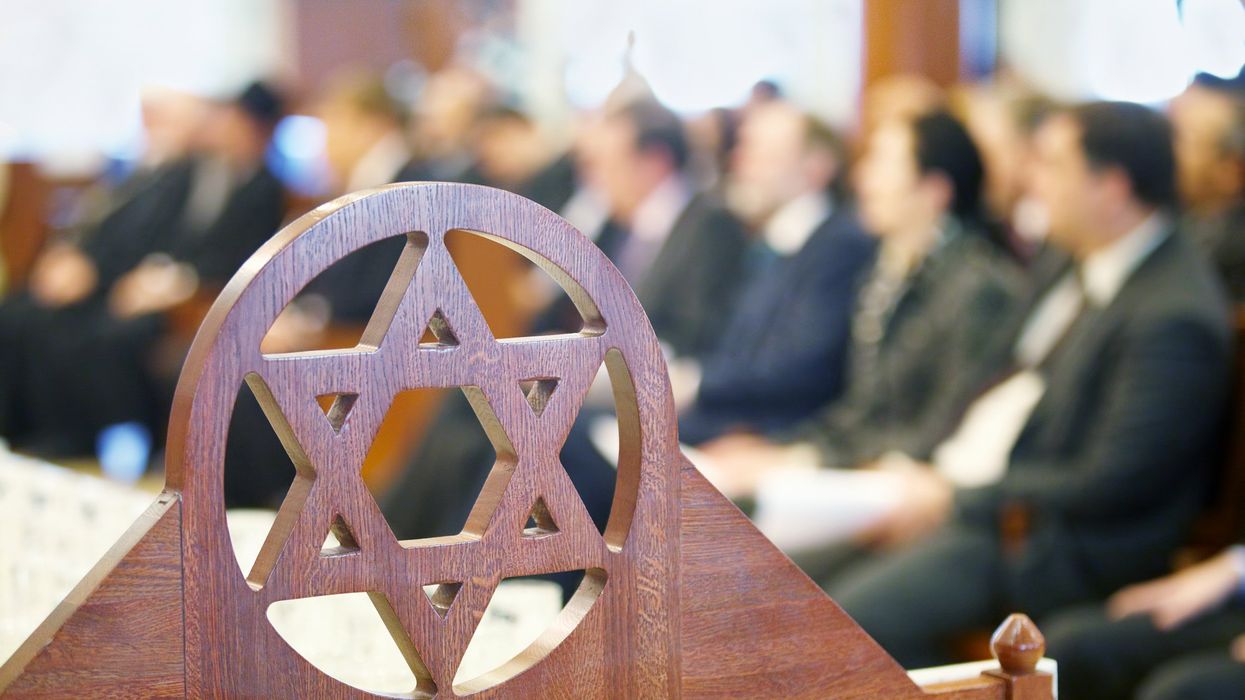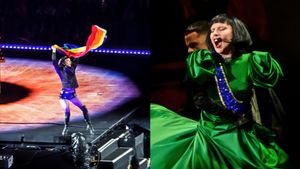(CNN) — When Zack Galifianakis asks Paul Rudd about his Jewishness in Between Two Ferns: The Movie, the actor responds with a quip.
"I'm not a practicing Jew," he says with a smirk. "I perfected it."
Rudd's now widely referenced line nods to a sentiment felt by many Jews: There isn't any one way to be Jewish. Judaism is one of the world's oldest surviving religions. But Jewishness is more than that. Jews have shared customs, traditions and histories. People can be Jewish and secular. They can convert into the faith. There are Jews who consider themselves White and Jews who are people of color. At various points in time, the Jewish people have been characterized as a nation, an ethnicity, and a race.
Trying to distill Jewishness into any one classification is unproductive — both because of how slippery these categories are to begin with and because Jews view their own identity in all kinds of different ways. But scholars and leaders who have spent time thinking about these questions generally agree that Jewishness is an expansive, intersectional identity that can't quite be captured by a checkbox on a form. That's especially the case in the US, where race is often discussed in Black and White terms and those outside the two categories are often overlooked.
"The Jewish story, in particular, shows that it's much more complicated," said Eric Goldstein, a history professor at Emory University and author of The Price of Whiteness: Jews, Race, and American Identity.
Many Jews in the US who present as White have come to be seen as part of the nation's dominant White majority. But as anti-Semitism has seeped into the mainstream, and as threats and violence against Jewish people have become more prevalent, questions about where Jews fit into the country's racial landscape endure.
How Jews have been perceived in the US has shifted over time
To make sense of these questions, it's important to recognize that the concept of race is not a fixed category, but rather a social construct with boundaries that have shifted over time. In some ways, the story of many American Jews is a story about those shifting boundaries.
"It's not that Jews aren't White," said Cheryl Greenberg, a professor of history at Trinity College whose research explores Black-Jewish relations. "It's that Jews are White in one sense, and not in another."
Legally, Jews have almost always been considered White in the US. Unlike people of African, Asian, Latino, and Native origin, most Jewish immigrants were not specifically excluded from US citizenship because of their Jewish identity. But they weren't immediately accepted into the dominant ruling class either. Instead, their place in mainstream White society was rather ambiguous.
"They were a group that defied easy categorization, and they tended to challenge — and in some cases, upend — the easy definition of American society into the categories of Black and White," said Goldstein.
Historians generally refer to three waves of Jewish immigration to the US. A small number of primarily Sephardic Jews (meaning they had roots in Spain and Portugal) came over during the colonial period, and another wave of Jews from German-speaking countries settled in the US between 1820 and 1880. But it wasn't until the late 19th and early 20th centuries that Jewish immigrants started coming to the US in large numbers. More than 2 million immigrants arrived from Eastern Europe between 1880 and 1924, and much of the American Jewish population can trace their roots to this third wave, according to Goldstein.
These second and third wave immigrants were primarily Ashkenazi Jews (meaning they were of German or Eastern European descent). But unlike their earlier German counterparts, Jewish immigrants from Eastern Europe did not assimilate as quickly into mainstream American society, Goldstein said. They were poorer and tended to cluster in dense ethnic enclaves. They also came to the US at a time when industrialization and an influx of immigration were fueling economic and political anxieties, and subsequently were scapegoated for larger societal shifts.
From the late 19th century to the early 20th century, anti-Semitic sentiment continued to grow in the US, reaching a peak during the period between World Wars I and II. Jewish people were stereotyped in the media, barred from owning property in certain neighborhoods, subject to quotas at colleges and universities and excluded from social clubs and places of employment. Prominent figures such as Henry Ford promoted anti-Semitic propaganda and conspiracies that characterized Jews as part of a cabal that sought to control the world (a familiar refrain for anti-Semites today).
At the time, Jews in the US were considered a separate race within a larger category of White — as were groups such as the Italians and the Irish. In this context, however, the term race had a somewhat different connotation than it does now, according to Goldstein.
"It indicated some type of biological, physical difference that was inheritable. It often was a way of expressing the belief that a group had a particular character that was different from the mainstream society," he said. "It does not mean [Jewish people] were considered Black, and it didn't necessarily mean that they were considered non-White."
This understanding of race was also connected to eugenics and scientific racism, which gained popularity during the early 20th century and attempted to rank groups based on their "desirability" and their potential to assimilate into the White Protestant mainstream.
Today, the notion of Jews as a separate race evokes the ideology of Nazi Germany and White supremacists. But Goldstein said some Jews during this earlier period referred to themselves as a race proudly. Torn between the pressure to assimilate into the American mainstream and the desire to hold onto their Jewish identity, the language of race became a way to assert themselves as a distinct community.
World War II was a turning point for American Jews
Central and Eastern European Jewish immigrants were considered outsiders in their countries of origin. In the US, these groups encountered a society that was largely divided into Black and White, prompting a shift in how they presented and viewed themselves.
"You can't understand how Jewish immigrants became part of American society without understanding the pressures and requirements and expectations that those categories placed on acculturating immigrants," Goldstein said.
For many Jewish immigrants in the 20th century, assimilating into the White Protestant population offered a semblance of safety. As a result, some Jews positioned themselves as distinct from African Americans, said Greenberg.
There were certainly examples of Black-Jewish solidarity during this time — the Jewish press reacted to Black lynchings with outrage and Jewish community leader Henry Moskowitz notably helped found the NAACP in 1909. But some Jewish entertainers during this period also signaled identification with the White Protestant majority by donning blackface, and some Yiddish newspapers expressed ambivalence and anti-Black attitudes in their coverage of incidents such as the Tulsa Race Massacre (even as they drew parallels between the plight of African Americans in the US and Jews in Eastern Europe).
The tide began to turn during World War II, said Greenberg.
"Once Nazism emerged, and then a Nazi look-alike movement in the United States emerged, it was quite clear that Jews were in trouble, too," she said. "So you see Jewish organizations and Jewish individuals joining efforts of the Black community to challenge racial discrimination."
The deepening allyship between the two groups came as the racial position of American Jews started to shift. With the Holocaust predicated on the idea that the Jews were an inferior race, it was no longer socially acceptable to think of Jews as racially distinct. Overt anti-Semitism also declined as the economic anxieties of the early 20th century gave way to the prosperity of the post-war boom. As the racial color line hardened, Ashkenazi Jews who presented as White were eventually subsumed into the White mainstream — for instance, Jewish veterans were able to take advantage of the GI Bill when their African American counterparts were not.
Despite greater acceptance, Goldstein said Jews in the US didn't just "become White." Jewish inclusion into the White mainstream was conditional — accessing the benefits that come with being part of the dominant population often came at the expense of maintaining a distinct ethnic identity. And though society was beginning to see them as White, Jews didn't necessarily see themselves as that way given their long history of marginalization. So, as they achieved a more secure position in American society, some asserted their differences.
"There was a clash between experiencing this exceptional level of integration and then thinking of yourself as part of an oppressed minority group," Goldstein added. "There's always been that contradiction in Jewish identity."
This contradiction was evident during the Civil Rights Movement, said Greenberg. Many Jewish groups and individuals joined the fight against segregation and racial discrimination by pointing to their own experiences of persecution.
Some prominent Jewish organizations filed amicus briefs in landmark civil rights cases. Jews also marched in Selma, Alabama, alongside Martin Luther King Jr. and risked their lives to register Black voters in the South. At the same time, many Jews had opportunities and advantages that Black people did not, which caused some tensions between the two groups.
"From the point of view of most White people, Jews were way more engaged and they made the choice to ally themselves with another disadvantaged community in order to protect equality for everyone," Greenberg said. "From the African American side, that was great, but Jews also had this economic power — because they were White — that they were not using necessarily to help the cause."
As the rise of Black nationalism drew more attention to these economic imbalances, the so-called Black-Jewish alliance began to splinter. But in spite of some clashes between the two groups, Jewish political movements such as Zionism were also influenced by Black nationalist thinking and vice versa.
Some Jews benefit from White privilege while still facing prejudice
In the decades since World War II, Jewish people who present as White and have European ancestors have largely been absorbed into White American society. Today, a vast majority of US Jews — 92 percent — identify as White, according to a Pew Research Center survey.
But the events of the past few years have once again called that status into question.
In 2017, a group of neo-Nazis and White nationalists marched through Charlottesville, Virginia, torches in hand, chanting "Jews will not replace us." In 2018, a gunman, who reportedly told an officer he wanted all Jews to die, launched an attack on a Pittsburgh synagogue that left 11 worshippers dead. In 2019, another shooter opened fire on a San Diego area synagogue. Anti-Semitic graffiti and messaging have surfaced in schools, homes and public spaces, and hateful rhetoric has been perpetuated by music superstars, athletes, and politicians.
The resurgence of overt anti-Semitism has underscored just how limiting the category of race is, said Rabbi Jacob Blumenthal, CEO of the United Synagogue of Conservative Judaism and the Rabbinical Assembly. Anti-Semitism affects both Jews who present as White and benefit from White privilege, as well as Jews of other races.
"For a group that is so identified with being White, it's interesting that Jews face so much prejudice in the United States," Blumenthal said. "For some people who identify as people of color, it's also hard for them to understand that a community that seems to be associated with Whiteness would still face that kind of prejudice and discrimination and even violence."
However successful some Jews in the US have been at integrating into the mainstream White population, the community continues to be "othered" by some non-Jewish White people, as well as by groups who have experienced steeper barriers to entry into the establishment, said Brad Levenberg, a senior rabbi at the Reform synagogue Temple Sinai Atlanta.
"Being Jewish in America today occasionally feels like this: 'You can be like us, but you're never going to be one of us,'" he wrote in an email to CNN.
The US Jewish population is diverse
The conversation about whether Jews should be considered White also obscures the increasing diversity of the American Jewish population.
Larger communities of Sephardic and Mizrahi Jews (those of Middle Eastern or North African origin) have settled in the US in the last several decades, while researchers estimate that roughly 12 to 15 percent of American Jews are people of color. Still, that diversity often isn't reflected in Jewish spaces, said Ilana Kaufman, CEO of the Jews of Color Initiative.
"We're still in a system that thinks of itself as mostly White and puts out communications, narratives [and] perspectives that reflect that narrow understanding," Kaufman said.
Because of such attitudes, Jews of color can sometimes feel alienated or excluded by the wider Jewish community, said Amanda Beckenstein Mbuvi, vice president of academic affairs at the Reconstructionist Rabbinical College.
"There's a way in which conversations about anti-Semitism sometimes interact with conversations about race, which is really not helpful," she said. "It's like, 'Well, there's anti-Semitism. Therefore, racism is not a Jewish problem because Jews are victims."
Mbuvi said being Black and Jewish has given her a unique window into how perceptions of Jewishness are shaped by social constructs. There have been Jewish communities scattered all over the world for millennia. Yet people are often confused as to how someone could be Black and Jewish — a reaction that Mbuvi sees as more American than anything else.
To ask whether Jews are White or whether they constitute a race or ethnicity is the wrong question, Mbuvi said, because these categories have never been fixed.
"It's a signal to us to reexamine the system, and to re-examine the boxes that we use and the questions that we ask," she added.
Jewishness is difficult to characterize because the terms we use to talk about identity were never meant to describe it, Mbuvi said. But in all its contradictions and ambiguity, it might push us toward new ways of thinking.
The-CNN-Wire
™ & © 2023 Cable News Network, Inc., a Warner Bros. Discovery Company. All rights reserved.

















































